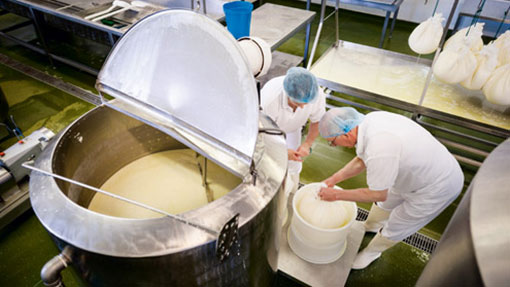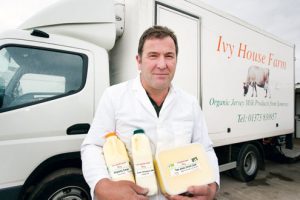How-to guide on processing your own milk

Processing milk can be a way to add value to your dairy business, but it is important to plan well to get your new venture off the ground and give it every chance of success.
We talk you through the process from starting out to marketing to contracts and find out how two Somerset dairy farmers turned a struggling dairy into a thriving processing business.
Getting started
Doing your research is vital. From deciding what you want to produce, to identifying your market and your potential customer base, being properly prepared is key, says DairyCo’s Amanda Ball.
“As well as establishing if there is a gap in the market and consumer demand for a product, you need to determine your capabilities,” she says.
“Do a feasibility study to work out your capital costs, look at the technical requirements needed to produce different products and think carefully about whether you have the staff, time and energy to carry a project through.”
Starting from scratch with on-farm processing can be an expensive move, especially when it requires new buildings to be able to carry out operations, she says.
Cheaper options might include off-farm developments, where farmers rent facilities, or a co-operative start-up where local farmers come together to make a larger-scale venture.
Alternatively, a farmer might look into collaborative ventures, where they supply milk in bulk to an artisan cheese-maker.
“Building a business model for different scenarios will help you work out which one could work for you,” says John Allen of Kite Consulting.
“Farmers have to be prepared that these projects don’t always work, but having laid the proper groundwork through proper research in the first place can help.”
What to process
Different products require different levels of capital to produce, which will determine what a farmer might consider processing.
Liquid milks
Pros
Requires only basic premises (although they must meet local Environmental Health standards).
Abundance of second-hand processing equipment available, which could make set-up costs reasonably low.
Cons
Short shelf-life – customer bases may need to be local to ensure it can be delivered to them quickly and easily.
A difficult market to get into as it can be tough to find a contract to shift large volumes of milk every day.
Value-added products (yoghurt, cheese and ice-cream)
Pros
There have been some very successful examples such as Rachel’s Organic and if you’re innovative enough you may be able to spot a gap in the consumer market.
Cons
Higher outlay cost as the process uses more specialised plant equipment and premises can be more expensive to kit out as they require higher levels of hygiene and control.
Advice
From John Allen of Kite Consulting
Do your research
Having an innovative product alone isn’t the answer – your product needs to fulfil a customer need and you have to be able to get it to the customer.
Plan for surplus supplies
Different products require different volumes of milk, so if you produce 500,000 litres of milk, but want to produce ice-cream – which only uses a tiny amount – you will need to find an alternative market for what you have left.
Get trained
Taking a course on milk processing or cheese production at colleges such as Reaseheath to help you understand production processes, supply chains and their management could be a good place to start.
Regulations
All food businesses need to be registered with their local authority and inspected and licensed by the Environmental Health department.
Environmental Health will advise you on building layout, equipment and training requirements, and will also issue you with a food mark to display on your packaging.
Trading standards must also approve labels and anyone selling through a retailer may need to register a barcode.
At least one person must have a basic food hygiene certificate, and you will need to draw up Hazard Analysis Critical Control Points procedures for the processing facility.
Larger-scale operations may need to apply for planning permission, and if you buy in and process other farmers’ milk you may have to pay business rates.
Depending on where you sell your product, regional and national retailers may also have their own accreditations and standards.
It is also important to be aware of the Weights and Measures Act and the Food Safety Act.
The Food Standards Agency is a good place to start for advice on food safety and standards and how to set up your business.
Marketing
Marketing and sales strategy should revolve around having the right product, price, time, production and positioning.
Gap in the market
You need to produce something that fills a gap in the market and provides consumers with something they want and need – whether that’s due to convenience or because it fulfils an emotion or aspiration, such as organic or local.
“Customers will generally be receptive to selling points such as local, better taste, traceable or indulgent, but they will be driven by value, offers, quality and taste,” DairyCo’s Amanda Ball says.
Packaging
Consider the packaging – all products have an image or brand personality, and it is important your design reflects this.
“When it comes to packaging, have a look at other products out there for inspiration and make a note of what looks good or what meets customer demands in terms of convenience, such as resealable containers.”
Pricing
No matter how good your packaging is, you have to make sure you build in a pricing strategy in your marketing plan which allows your business to be viable.
Consider the lowest price you will accept, any volume discounts and what the life cycle of the product is before you redesign packaging.
If you are a new entrant to the market and your product has a high price, you need to justify the reasons behind it. Conversely, a lower-priced product doesn’t always convey the image you need to differentiate your brand in a crowded marketplace.
Personality
Putting a personality behind products that have become faceless – such as liquid milk – can help with their appeal to consumers.
“You ideally want someone enthusiastic who can win over customers and be a good promoter,” says John Allen of Kite Consulting. “Very often people start off at farmers’ markets, and being a good communicator is vital if you want to build a customer base.”
See also: Video: Ice cream diversification doubles value of litre of milk
Contracts
There are a number of routes to market and the best one for you can depend on your product, your resources and the volumes you are producing.
Local outlets
Local markets such as farm shops, farmers’ markets, local speciality food shops, hotels and cafes may be a first place to try, although it can be a competitive market.
“In liquid milk, especially, shifting the large volumes that many producers may need to sell to be profitable locally can be tough, especially when you will be up against the likes of Medina and Freshways,” says John Allen of Kite Consulting
Retailers
Approaching regional wholesalers, food hubs and retailers can be an option, but it is important farmers to have the capacity to grow supplies.
Getting into Tesco can be an amazing achievement, but you need to be sure you can meet demand and distribute the product.
You may need to adapt your production processes, moving to year-round calving to ensure a continuous milk flow, or look at buying in milk to ensure they have consistent supplies to make their product.
Case study: Geoff and Kim Bowles
Ivy House Farm, Somerset
The Bowles family moved into processing without major investment or borrowing money by buying machinery cheaply and adapting it to the business’ needs.
For Somerset dairy farmers Geoff and Kim Bowles and their family, the decision to process their own milk on farm was made out of necessity.
Faced with the proposition of closing his 80-head Friesian Holstein herd after a bypass scheme split his 73ha farm, making much of his land inaccessible, Mr Bowles knew the family had to do something different if they weren’t going to be forced out of business.
“We were struggling to see how we were going to survive, but then someone gave me some advice – we either had to go big, go niche or get out,” he says.
“We didn’t want to go big, and we definitely didn’t want to stop dairy farming, so we decided our only option was to go niche.”
Switch to organic
In 1998 Mr Bowles decided to go organic and switch to Jersey cows, as he thought their high-quality milk and cream would help him produce a product that would appeal to shoppers.
“At the time there had been a sudden interest in local food, which we thought we could capitalise on,” he says. “By producing an organic, local, Channel Island product, we went for as many niche markets as possible so we could tick many of the boxes shoppers would be looking for.”
Outlay
Moving to processing was done cheaply thanks to second-hand equipment and using existing buildings on the farm.
“There was no major investment and we never borrowed money to support the business,” Mr Bowles says.
They converted calving boxes into the creamery and bought machinery cheaply. Mr Bowles also has engineering experience, so was able to buy second-hand kit and adapt it to fit their needs.
After designing packaging cheaply themselves, the family started by producing Ivy House Farm cream, which they sold through local farm shops and cafes.
Farmers market to high-end retail
They were quickly asked to start producing milk and then added butter and buttermilk to their range, which they started to sell at farmers markets.
“The turning point was when we were in London at a farmers market,” Mr Bowles says.
“We were approached by Fortnum and Mason, which said it wanted something different because a Tesco local had opened opposite and they were selling similar products.
“They wanted a different, quality product and as ours is non-homogenised and organic, it appealed to them.”
After securing a contract to supply Fortnum and Mason, the Bowles approached other department stores, including Harrods and Selfridges.
“I just rang them to see if they were interested and they all said the same thing: the market was dominated by large processors, and they liked the sound of us.
“Milk has become a faceless product, but we personalised it and they bought into our story.
They don’t have an advertising budget and have instead grown slowly through word of mouth, going from a turnover of £20,000 to £500,000.
“We’re not doing anything ground-breaking, we have just personalised the business and brought a face back to milk production, which is what people have liked.”
Production system changes
Building a more formal customer base meant Mr Bowles and his son Darren, who now runs the farm, had to think differently about their production systems.
They switched to once-a-day milking as he found it was too time consuming to milk cows, process the milk and deliver the products themselves in one of their three refrigerated vans.
They use sexed semen and put six heifers into the herd every month to ensure an even flow of milk, while they have also had to adapt their feeding systems to ensure milk quality is maintained.
“We discovered that making significant changes to cows’ diets between summer and winter upset the balance in the rumen,” says Mr Bowles. “Until the flora built up in the stomachs, the fat globules in the milk would weaken, which would lead to the milk and cream splitting.”
Now the feed is managed throughout the year, with cows out to grass from March to November, but brought in each evening to maintain forage going in.

